Alzofon Art Institute Academy Lesson
How Do You Do Shading?
Back to: Shade, Light & Form
Modeling Entrance | Definitions/Topics
Recognizing Levels
of Illumination on a Subject

Lights
 Low Light
Low Light
 Medium Light
Medium Light
("Greatest Illumination" included within Medium
Light in this diagram)
 Highlight (reflection, not illumination)
Highlight (reflection, not illumination)
Energy Level Changes
As Form Turns from Light
Greatest Illumination
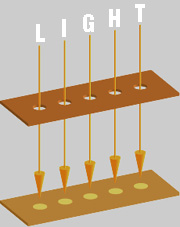
Here, a board with five holes allows
five units of light to pass through.
A board perpendicular to the flow of
light, receives all five units of light.
Low Light
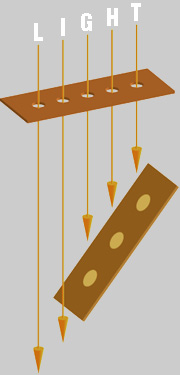
Now, the receiving board is tilted.
With more tilt, fewer units strike.
This means that as form turns
from the light source, angled
areas receive lower levels
of light energy.
Energy Changes Within
Single Beams of Light
Weak illumination from above, striking horizontal surface
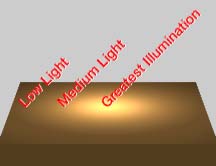
A lamp will illuminate most strongly on a surface closest to it.
The level of illumination will drop off as the distance from
the light source increases.
Some lamps direct the flow of light so that there is a concentrated
center to the beam. Away from the center, light energy decreases.
Weak illumination from above, striking generally vertical subject
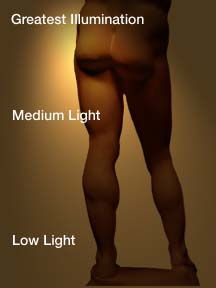
Light energy drops with distance away from a weak source.
This means that a top lit vertical subject will appear to
darken downward.
The Color of Light Changes
as Energy Levels Change.
Yes, it's true. Let me show you.
This is a digital photo of my studio lamp.
It is illuminating a glossy white plastic sheet.
The ceiling above is white. Everything is white.
The lamp is the primary light source, emitting the greatest illumination.
It, and its reflection are white. But look at the "Light" area.
That's darker, and yellow; the "Low Light" is darker and becoming
redder; and the "Reflected Light" from the plastic sheet is quite
red (but yellowish red at center). This is a color (and value) recording
of light energy levels.
This has important implications for painting.
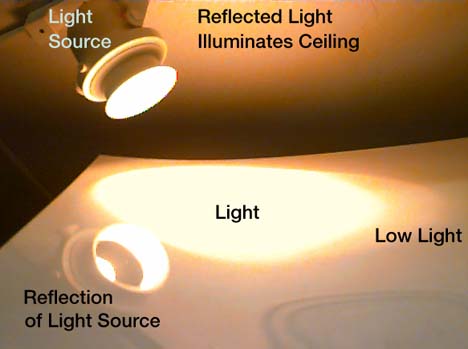
The Highlight is Not Part
of the Level of Illumination System.
Look again at the above photo. Notice that the beam of light forms a yellow
oval on the plastic sheet. This is the area of greatest illumination. Now,
notice that the reflection of the light source (the highlight) is below,
off to the side of the yellow oval. If you could walk around this sheet
of plastic, you would discover that the reflection of the light source moves
with you, but the illumination area stays in the same position.
This has important implications for painting and drawing.
Back to: Shade, Light & Form Modeling Entrance
| Definitions/Topics
What's
New? | Shortcut
Entrances: | Studio
| Alzofon Art Institute | Guest
Wing, Link Room | Idea
Library | Academy |
Rebecca Alzofon
can be e-mailed at rebecca@art.net
This page created October 9, 1996



Low Light
Medium Light
("Greatest Illumination" included within Medium Light in this diagram)Highlight (reflection, not illumination)




